Disclosure: Meeple Mountain received a free copy of this product in exchange for an honest, unbiased review. This review is not intended to be an endorsement.
If you have been around the hobby of gaming over the last 5 years—or gone shopping at your local Target’s gaming section in that same time frame—you have likely seen the game Kingdomino, one of the most celebrated casual games of our generation. It was nominated for, or outright won, every major gaming award in 2017 culminating in the Spiel des Jahres award that year. (Our team loved Kingdomino too.)
I’ve owned a copy of Kingdomino for a couple years and yes, I bought my copy at Target. That version came with a handy domino tower so that I didn’t have to fiddle with something as arduous as stacking dominos on my own. (I’m lazy.)
Publisher Blue Orange Games (known as just Blue Orange in Europe) has gone to the well aplenty with the Kingdomino brand: the Age of Giants expansion, Kingdomino Duel, Dragonimo (a kid’s version of Kingdomino!), and Queendomino, a standalone game that builds on the base game’s mechanics as a reportedly more strategic entry in this series. I have not played any of these other games, but all have been generally well received by our team and the tabletop media at large.
Kingdomino: Origins, the newest entry in this family, arrived on my doorstep for Thanksgiving. After enjoying a little too much turkey, I thought about the words “too much” quite a bit each time I played Kingdomino: Origins. I am really caught in a quandary: is more better? Or is more just too much?
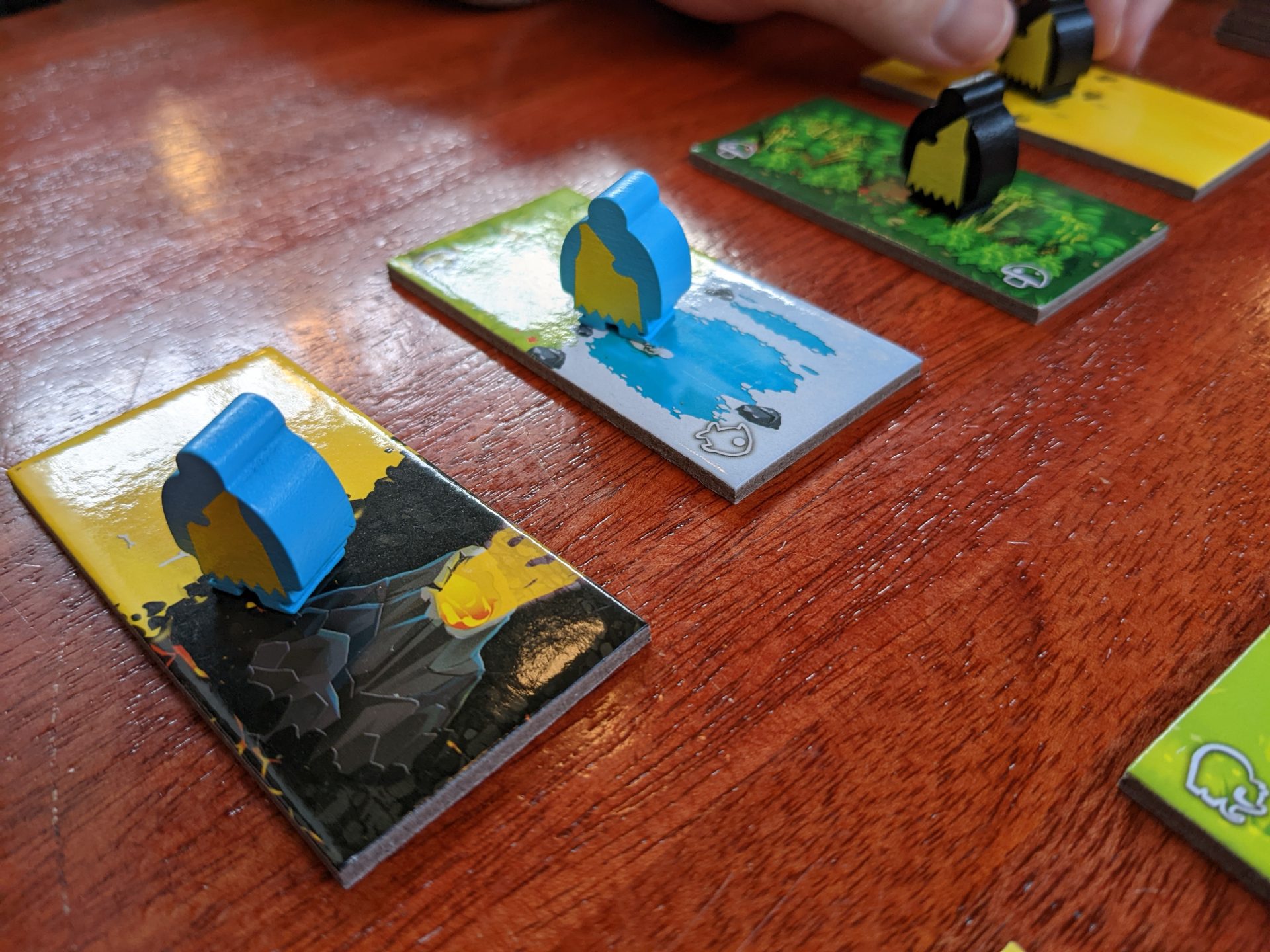
A Game in Three Parts
Kingdomino Origins sticks to the playbook for the base gameplay of the series, by having players select dominoes to place in a tableau surrounding a starting tile (in this game, it’s a hut instead of a castle), building up to a 5×5 grid of tiles that scores you points based on just one requirement: multiply the number of tiles sharing the same terrain type by the number of crowns…whoops, fire symbols pre-printed on tiles as well as fire symbols placed during gameplay.
These fire symbol tokens are placed thanks to volcano tiles, a new addition to Kingdomino Origins.
Yes, volcanoes. You see, instead of taking place in an era where royals seek to expand their kingdom, Kingdomino Origins goes back even further to prehistoric times where there are volcanoes, mammoths, tribal chiefs, and cavemen. And instead of crown points, you are trying to score the most (wait for it!!!)…”comfort points.”
I’ll let that one simmer for a bit. One of the folks in my review group, Summer, admitted that the use of the term comfort points was “creepy”. While I’m all for originality in games, I always wonder why designers don’t stick to just using the single word points to address scoring. Points. POINTS!
Kingdomino Origins comes with 3 gameplay modes. While I generally love that games offer a chance to scale complexity up or down based on the audience, I think that backfires in the case of Kingdomino Origins.

Discovery Mode
Discovery Mode, to its credit, is exactly what it says it should be: this is the way you should play Kingdomino Origins if you have never played another Kingdomino game. Ultimately, it’s also the best way to play ANY version of Kingdomino.
The rules from the other games in the Kingdomino family are the core of Discovery Mode; for more, feel free to revisit our review of Kingdomino. Build a 5×5 grid and score the most points. The only new wrinkle involves those volcano tiles, which essentially erupt fire tokens to other parts of your tableau, helping sections that don’t have pre-printed fire symbols score. This is also quite useful when you want to spike the scoring on a section that is already a big one; I used it in my first game to make a 6-tile section score a whopping 48 points.
Volcanoes are the perfect remix for the gameplay loop of the Kingdomino family. This shakes up the game just a little, but the way it shakes up gameplay makes Kingdomino Origins feel very fresh.
No one in my review group had played the base game, so I started with Discovery Mode for our first play. This worked wonders and is easy to learn for an experienced gamer. But for established Kingdomino players, proceed directly to Totem mode!
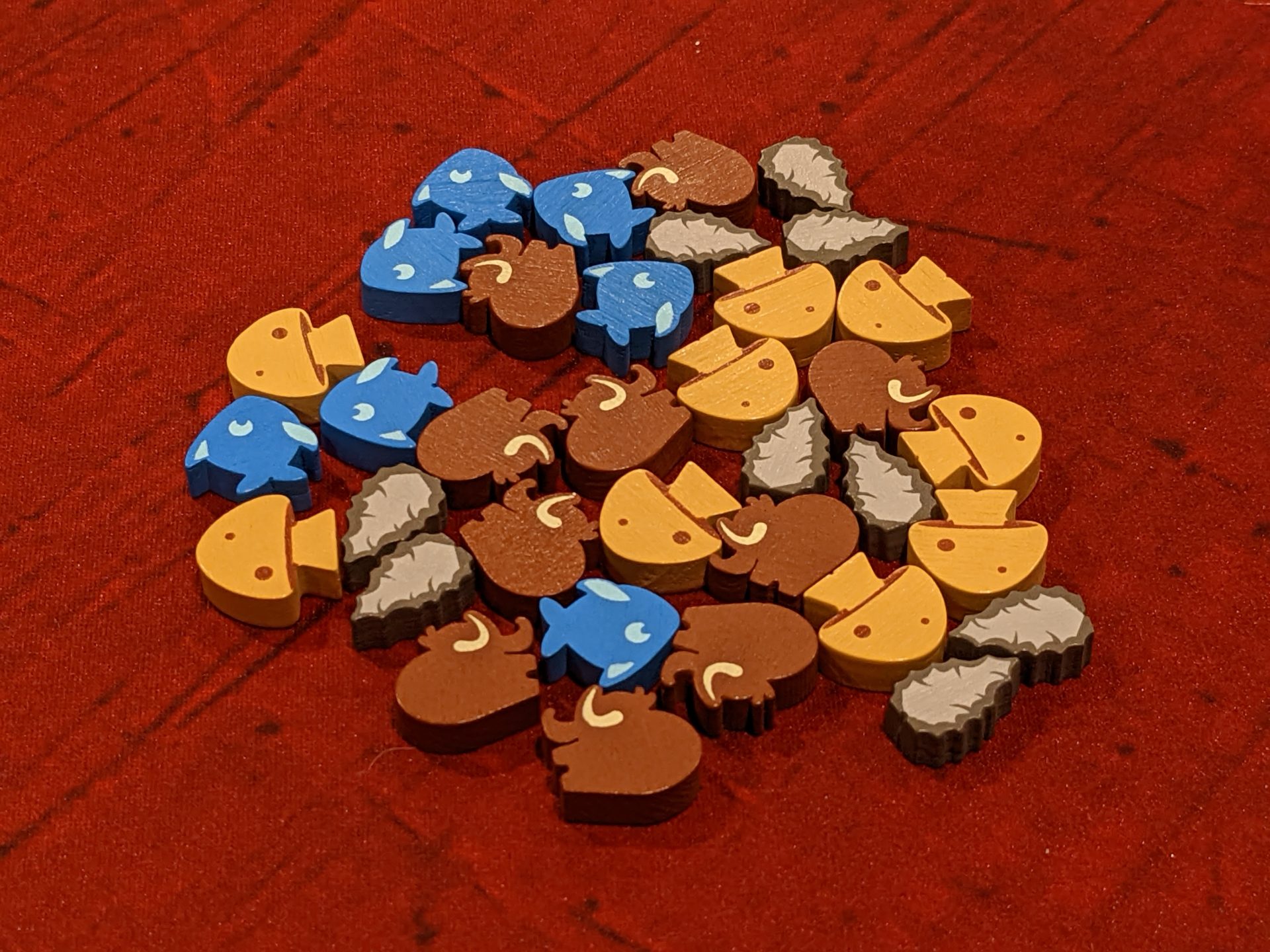
Totem Mode
Totem Mode only adds one new gameplay element: a tug-of-war majority scoring element tied to the player who has the most of any of the 4 resources added into the game: mammoths, fish, mushrooms, and flint. Each time one of 4 tile types is added to the available column of new dominoes (grasslands, lakes, jungles and quarries), you’ll drop a mammoth, fish, mushroom or flint token on that half of the domino, respectively.
The resources are then added with the tile you’ve chosen into your growing territory as the game progresses. Volcanoes add an element of destruction: if you add fire to a space where there was a resource, that resource is removed from the game. That tradeoff is almost always worth it, of course; adding fire to an area of your board that would not otherwise score is the main way to score big in this game.
And that’s it. At the end of the game, you’ll get a point for each resource still sitting on tiles in your tableau. The player with the clear majority with each of the 4 resource types will then score a bonus ranging from 3-6 points.
Totem Mode is so minor that I actually never ONLY added Totem Mode to a game of Kingdomino Origins. I stuck with adding this into games with Tribe Mode only. I’m not really sure why the design team wanted to add Totem Mode, but the resources are admittedly quite cute.
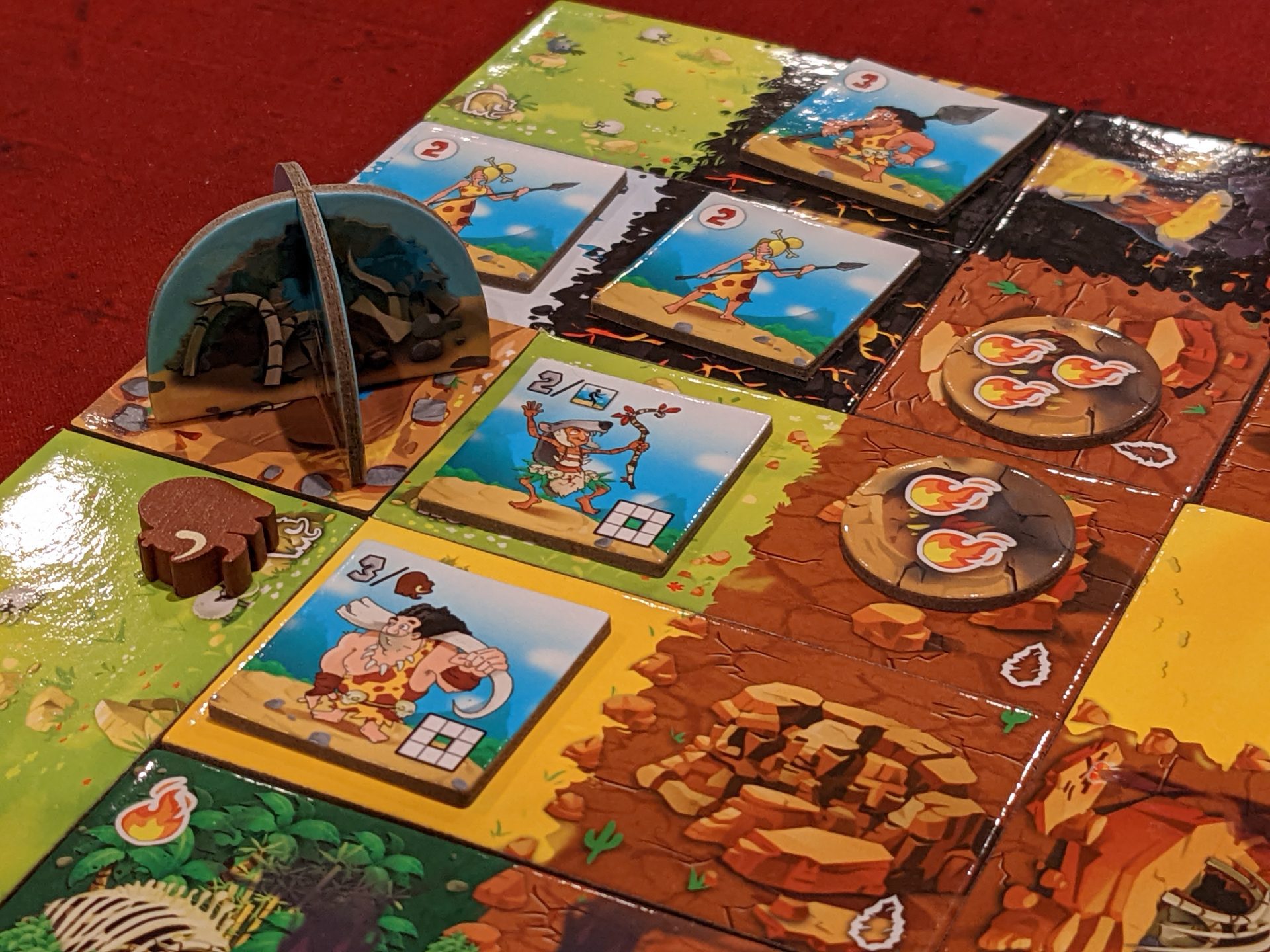
Tribe Mode
Tribe Mode adds cavemen tiles! In Tribe Mode, there is a market of 4 face-up cavemen tiles which boost scoring opportunities to the first 2 modes in the game. (In other words, you cannot play Tribe Mode without also adding Totem Mode.)
Once you have chosen your domino for the following round, you can spend two different resource tokens from your existing placed dominoes to take a face-up caveman token from the market. There are 2 types of cavemen: hunter-gatherers and warriors. Both types can be placed on any empty tile that does not have a pre-printed fire symbol, fire tokens, or your home cave. A maximum of one caveman tile can reside on any one square in your tableau.
Warriors score based on perpendicular adjacency (orthogonal and diagonal) to other warriors using the same formula everything else scores in the base game: the number of warriors multiplied by the total power of the warriors touching each other. Hunter-gatherers score based on the tiles and resources adjacent to the 8 spaces surrounding them (again, orthogonal and diagonal, much like one of our favorite games, Carcassonne).
Tribe Mode adds quite a bit of analysis paralysis each turn as you try to figure out the best place to spend resources to add cavemen, while also managing how to make your largest sections of the board score a ton of points. In my plays, Tribe Mode easily adds 10-15 minutes to a game; just playing with Discovery Mode only takes 10-15 minutes even with 4 players. Upkeep is also a minor pain in Tribe Mode, as one person is assigned the task of adding resources to each new tile that requires them.
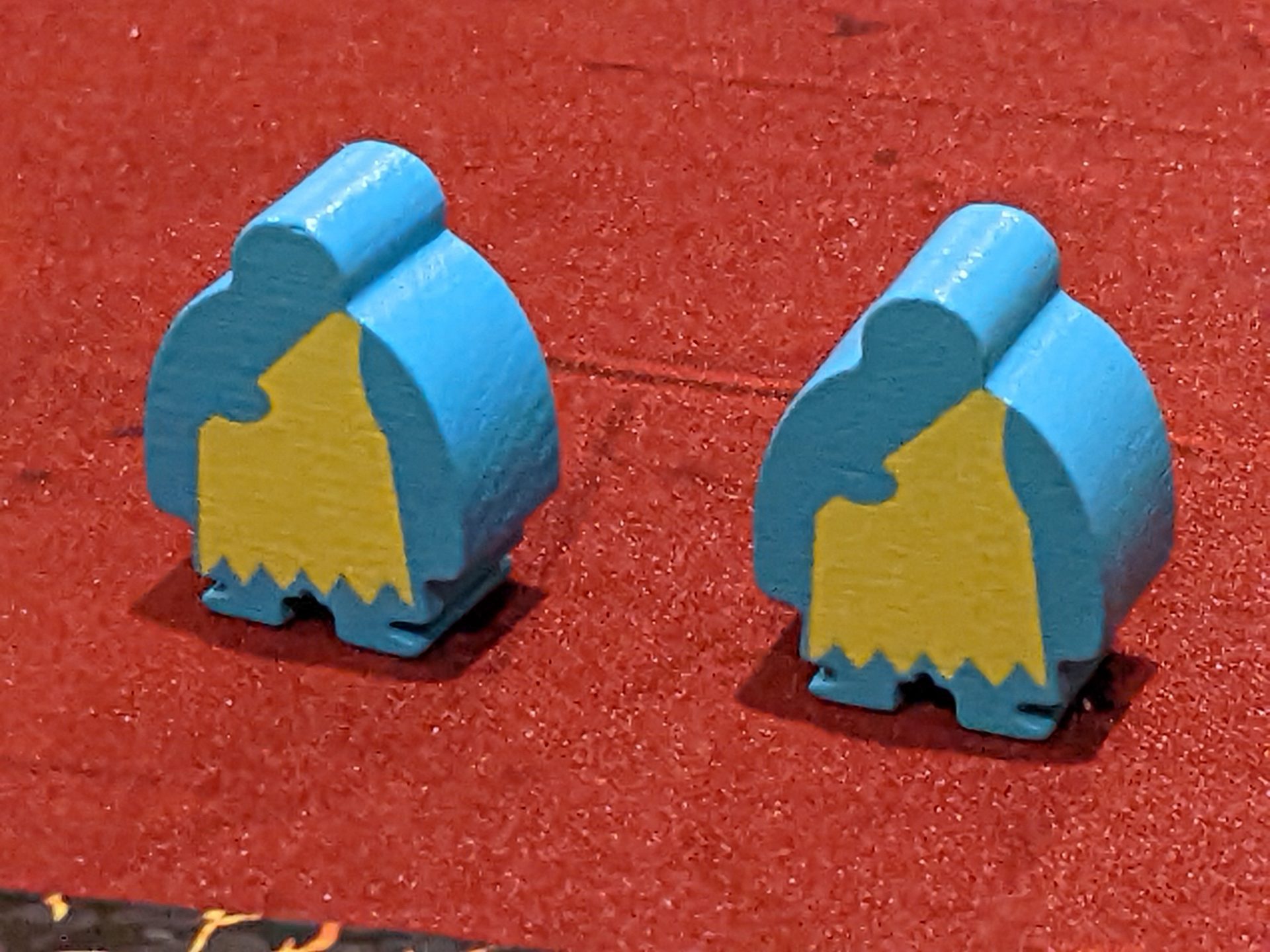
Do You Need More Kingdomino?
Kingdomino Origins is for 2 distinct audiences:
- You have played Kingdomino, the base game, dozens or maybe even hundreds of times in person or on Board Game Arena, and you have been chomping at the bit for more ways to build 5×5 grids with a new skin/theme. Further, the base game just isn’t high-scoring enough for you, and you are looking for ways to hit triple digit scores with proper planning. As a completionist, your sense of FOMO will be too much to bear, so picking up Kingdomino Origins allows you to complete the set.
- You have never waded into the Kingdomino pond—dare I say, ocean!!—and you are looking for the definitive Kingdomino experience. If you don’t own a Kingdomino game, and you are looking for the version that you can play with friends or your growing family for the rest of time, Kingdomino Origins is for you.
If you have Kingdomino already, and you like it but don’t love it, I don’t think Origins will put it over the top for you. If you have Queendomino and are satisfied with that, I’m also not sure you need to add Kingdomino Origins based on what I’ve read about that prior game. And even if pre-historic theme games are your thing and you are looking for a light filler, I don’t think Kingdomino Origins will be quite “caveman” enough for you!
The “worst” thing about Kingdomino Origins for me is that Totem and Tribe Modes add way too much complexity to a game that is beautiful in its simplicity. Adding resources to turn this into a track run makes Totem Mode something I will never add to the base Discovery mode experience.
All of the players who I introduced to Tribe Mode felt it was overkill. If I’m playing a game like Kingdomino in the first place, I don’t need 3 different systems layered on top of each other. Imagine playing, say, Azul then realizing you had to 3-D stack the tiles a certain way on top of each other to score more points. Might be interesting, but it’s completely unnecessary.
The best thing about Kingdomino Origins is that the Discovery Mode adds an interesting layer to a game that was already great, without changing the core gameplay. Instead of crowns, we get fires, and in this format, you can add fires to sections that don’t have any other way to score to give you an advantage. Nothing else changes, and you can get that plus some expansion content that you may or may not use for only $20 USD. Prior to writing this review, I donated my copy of base Kingdomino to another family moving out of Chicago; I just don’t need it now, because Origins is the better version.
Kingdomino Origins makes the Kingdomino experience better. It is certainly not groundbreaking, because at its core we still have Kingdomino here. But it does freshen up a game that has gotten a little long in the tooth!


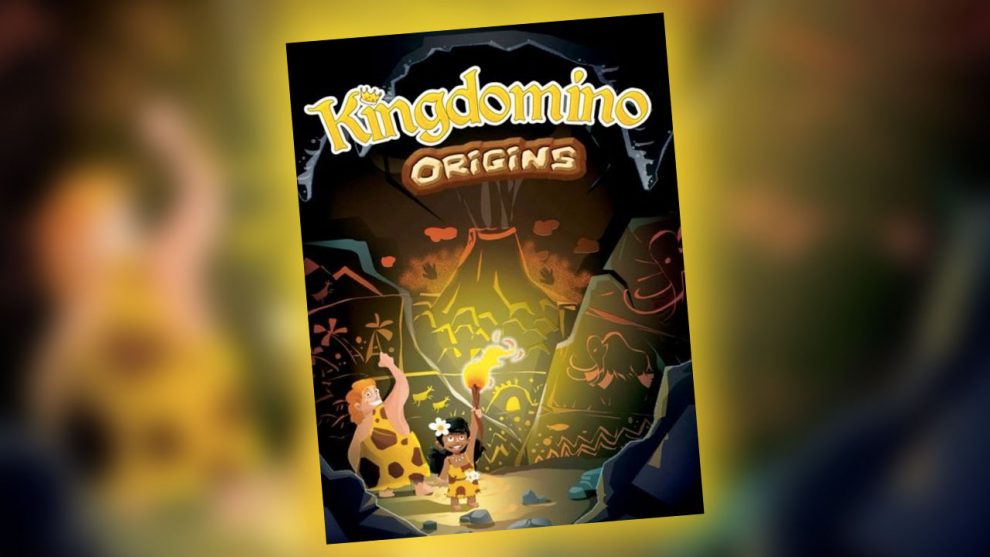









Add Comment